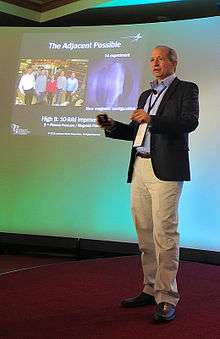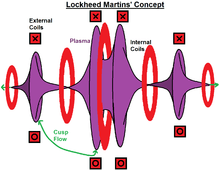Lockheed Martin Compact Fusion Reactor

The Lockheed Martin Compact Fusion Reactor is a nuclear fusion reactor. It is the goal of a project at Lockheed Martin’s Skunk Works. It is also known as a high-beta fusion reactor.[1]
The "high-beta" configuration allows a compact fusion reactor (CFR) design and speedier development.
High beta implies that the ratio of plasma pressure to magnetic pressure is greater than or equal to 1. By contrast tokamak designs reach only 0.05.[2]
The CFR chief designer and technical team lead is Thomas McGuire.[3] McGuire studied fusion as a source of space propulsion in response to a NASA desire to improve travel times to Mars.[4][5][6]
History
The project began in 2010.[7] The project was first presented at the Google Solve for X forum on February 7, 2013.
In October 2014 Lockheed Martin announced a plan to "build and test a compact fusion reactor in less than a year with a prototype to follow within five years".[8]
In May 2016, Rob Weiss announced that Lockheed Martin continued to support the project and would increase its investment in it.[2][9]
Design

CFR plans to achieve high beta (the ratio of plasma pressure to the magnetic pressure) by combining cusp confinement and magnetic mirrors to confine the plasma. Cusps are sharply bent magnetic fields. Ideally, the plasma forms a sheath along the surface of the cusps and plasma leaks out along the axis and edges of the sharply bent field.[10] The plasma lost along the edges recycles back into the cusps.
CFR uses two mirror sets. A pair of ring mirrors is placed inside the cylindrical reactor vessel at either end. The other mirror set encircles the reactor cylinder. The ring magnets produce a type of magnetic field known as a diamagnetic cusp, in which magnetic forces rapidly change direction and push the nuclei towards the midpoint between the two rings. The fields from the external magnets push the nuclei back towards the vessel ends.
Magnetic field strength is an increasing function of distance from the center. This implies that as the plasma pressure causes the plasma to expand, the magnetic field becomes stronger at the plasma edge, increasing containment.[2]
CFR employs superconducting magnets. These allow strong magnetic fields to be created with less energy than conventional magnets. The CFR has no net current, which Lockheed claimed eliminates the prime source of plasma instabilities. The plasma has a favorable surface-to-volume ratio, which improves confinement. The plasma's small volume reduces the energy needed to achieve fusion.
The project plans to replace the microwave emitters that heat the plasma in their prototypes with neutral beam injection, in which electrically neutral deuterium atoms transfer their energy to the plasma. Once initiated, the energy from fusion maintains the necessary temperature for subsequent fusion events.[7]
The eventual device may reach 21 m in width.[2] The company claims that each design iteration is shorter and far lower cost than large-scale projects such as the Joint European Torus, ITER or NIF.[11]
A 200 MW Pth reactor, 18 m long by 7 m in diameter, produces about a 2000 ton reactor, similar in size to an A5W nuclear submarine fission reactor.[12][13]
Challenges
Ring magnets require protection from the plasma's neutron radiation. Plasma temperatures must reach many millions of kelvins. Superconducting magnets must be kept just above absolute zero to maintain superconductivity.[7]
The "blanket" component that lines the reactor vessel has two functions: it captures the neutrons and transfers their energy to a coolant and forces the neutrons to collide with lithium atoms, transforming them into tritium to fuel the reactor. The blanket must be an estimated 80–150 cm thick and weigh 300–1000 tons.[7]
Prototypes
The "prototype" was planned to be a 100-megawatt deuterium and tritium reactor measuring 7 by 10 feet (2.1 by 3.0 m) that could fit on the back of a large truck and would be about one tenth the size of current reactor prototypes. 100 megawatts is enough to provide power for 80,000 people.[2][14] A series of prototypes were constructed to approach this goal.
T-4
Technical results presented on the T4 experiment in 2015 showed a cold, partially ionized plasma with the following parameters: peak electron temperature of 20 Electron volts, 1016 m−3 electron density, less than 1% ionization fraction and 3 kW of input power. No confinement or fusion reaction rates were presented.
McGuire presented two theoretical reactor concepts in 2015. One was an ideal configuration weighing 200 metric tons with 1 meter of cryogenic radiation shielding and 15 tesla magnets. The other was a conservative configuration weighing 2,000 metric tons, with 2 meters of cryogenic radiation shielding and 5 Tesla magnets.[15]
T4B
The T4B prototype was announced in 2016.[12]
Parameters:
- 1 m diameter × 2 m long
- 1 MW, 25 keV H-neutral beam heating power
- 3 ms duration
- Assume 500 kW is converted into fast ions.
- n = 5×1019 m−3
- β = 1 (field = 0.1 T)
- V = 0.2 m3, 1170 J total energy
- Peak Ti = 75 eV
- Peak Te = 250 eV
- Peak sheath loss = 228 kW, about equal to Pei
- Peak ring cusp loss = 15 kW
- Peak axial cusp loss = 1 kW
TX Reactor
Parameters:
- 7 m diameter × 18 m long, 1 m thick blankets
- 320 MW gross
- 40 MW heating power, 2.3 s
- n = 5×1020 m−3
- β = 1 (field = 2.3 T)
- V = 16.3 m3, 51 MJ total energy
- Ti = 9.6 keV
- Te = 12.6 keV
Intellectual property
In February 2018, Lockheed Martin was granted one patent.[16] It applied for three others.[17][18][19]
Criticism
Physics professor and director of the UK's national Fusion laboratory Steven Cowley called for more data, pointing out that the current thinking in fusion research is that "bigger is better". Other fusion reactors achieve 8 times improvement in heat confinement when machine size is doubled.[20]
See also
| Wikimedia Commons has media related to Lockheed Martin Compact Fusion Reactor. |
References
- ↑ FuseNet: The European Fusion Education Network, archived from the original on 2013-05-06
- 1 2 3 4 5 Wang, Brian (May 3, 2016). "Lockheed Portable Fusion project still making progress". Next Big Future. Retrieved 2016-07-27.
- ↑ Hedden, Carole (2014-10-20). "Meet The Leader Of Skunk Works' Compact Fusion Reactor Team". Aviation Week & Space Technology. Retrieved 2014-11-24.
- ↑ Norris, Guy (15 October 2014), "Skunk Works Reveals Compact Fusion Reactor Details", Aviation Week & Space Technology, archived from the original on 2014-10-17, retrieved 18 October 2014
- ↑ Norris, Guy (14 October 2014), "High Hopes – Can Compact Fusion Unlock New Power For Space And Air Transport?", Aviation Week & Space Technology, archived from the original on 18 October 2014
- ↑ Hedden, Carole (20 October 2014), "The Leader Of Skunk Works' Compact Fusion Reactor Team", Aviation Week & Space Technology, archived from the original on 18 October 2014
- 1 2 3 4 Nathan, Stuart (22 October 2014). "New details on compact fusion reveal scale of challenge". The Engineer. Retrieved 24 December 2017.
- ↑ Shalal, Andrea. "Lockheed says makes breakthrough on fusion energy project". Reuters. Retrieved 15 October 2014.
- ↑ Mehta, Aaron (May 3, 2016). "Lockheed Still Supporting Portable Nuclear Generator". Retrieved 2016-07-27.
- ↑ McGuire, Thomas. "The Lockheed Martin Compact Fusion Reactor." Thursday Colloquium. Princeton University, Princeton. 6 Aug. 2015. Lecture.
- ↑ Talbot, David (October 20, 2014). "Does Lockheed Martin Really Have a Breakthrough Fusion Machine?". Technology Review. Retrieved 24 December 2017.
- 1 2 "Lockheed Martin Compact Fusion Reactor Concept, Confinement Model and T4B Experiment" (PDF). Lockheed Martin Corporation. 2016. Archived from the original (PDF) on December 25, 2017. Retrieved 25 December 2017.
- ↑ wang, brian (1 May 2017). "Lockheed compact fusion reactor design about 100 times larger than first plans". NextBigFuture.com. New big future Inc. Retrieved 25 December 2017.
- ↑ Norris, Guy (20 October 2014). "Fusion Frontier". Aviation Week & Space Technology.
- ↑ Sullivan, Regina (November 20, 2015). "Preliminary density and temperature measurements in Lockheed Martin's magnetically encapsulated linear ring cusp confinement configuration". 57th Annual Meeting of the APS Division of Plasma Physics. 60 (10).
- ↑ US 20180047462A1 Encapsulating Magnetic Fields for Plasma Confinement. Google patent database
- ↑ US application 2014301518, Thomas John McGuire, "Magnetic Field Plasma Confinement for Compact Fusion Power"
- ↑ US application 2014301519, Thomas John McGuire, "Heating Plasma for Fusion Power Using Magnetic Field Oscillation"
- ↑ US application 2014301517, Thomas John McGuire, "Active Cooling of Structures Immersed in Plasma"
- ↑ McGarry, Brendan (16 October 2014), "Scientists Skeptical of Lockheed's Fusion Breakthrough", DefenseTech', retrieved 23 October 2014